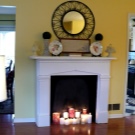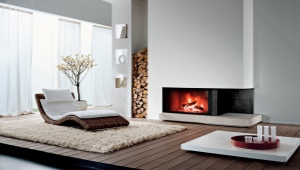Fireplace in the apartment with his own hands
Fireplace - a kind of stove that has an open access to the room. Heat is generated locally in it, which limits the space heated by it. Open fireplaces heat only a small part of the room, and fireplaces with a closed firebox allow to heat the whole house.
Once fireplaces were common everywhere, because they were used as a fireplace for heating at home and cooking. Now it is rather a decorative element, because the installation of a real wood-burning fireplace in a city apartment is possible only in 1 case out of 100.
How to install
Installing a real fireplace with a chimney in an ordinary apartment is almost impossible. But there are a number of nuances to add this element of decor.
- Firstly, the apartment in which the installation is planned should be located on the top floor of the house.
- Secondly, the owner of the apartment must receive two permits from the housing inspection: to redevelop the premises and to carry out the reconstruction work (the chimney system involves a change in the ceiling and the roof).
- Thirdly, even if the first two conditions are met by you, then it should be borne in mind that the maximum permissible load on the floor in a residential building, according to the norms of SNiP, should not exceed 150 kg / m2. The weight of an ordinary fireplace with a chimney and a metal firebox can easily reach 500 kg.
- Fourth, if the first three points did not convince you, then the cost of creating a wood-burning fireplace will be approximately 200,000 rubles.
Thus, sadly, one can only dream of an authentic fireplace in an apartment, sipping hot tea while sitting near an electric fireplace.
Types of fireplaces
Electric. This type of fireplace is most common in apartments. It is an electrical center connected to the network, which simulates the thermal and visual effect of burning wood. It heats the room, consuming about 2 kW of energy per hour. The advantage of this fireplace is that it can easily heat a room of 25 m2 to a comfortable temperature. In addition, the electrofireplace in the summer can work only in the visualization mode, without connecting the heating mode.
The fire chamber of an electrofireplace is most often stylized under cast iron casting. Internal elements can be different: imitate the burning of firewood, glowing coals or heated stones.In budget versions, fire imitations are performed by shreds of fabric that are driven by air flow. The firebox is only one part of the design, which is traditionally called the fireplace. In addition to the firebox, a portal is also needed (the outer front part is in the shape of the letter P, which frames the firebox and gives the fireplace a finished look).
Modern electric fireplaces are equipped with built-in steam generator. Water is poured into the built-in container, which is broken up into small particles and released to the outside. Due to the fact that the interior decoration is illuminated with lamps with light filters, the steam becomes similar to the smoke from the coals. A huge advantage of such models is the additional humidification of the air.
When choosing an electric fireplace, be guided by its power (for heating, the power should not be lower than 1.5 kW), on its dimensions (the smallest deep fireplace is 7 cm), the function for adjusting the brightness of the glow. Additional functions - imitation of the sounds of burning wood, steam generator.
Bio Fireplace This type of fireplace is fundamentally different from the electric: it does not imitate a flame, it really burns.Gas burners are installed in its working space, which set fire to biofuels for fireplaces (liquid), as a result of which there is a process of heat release and lighting.
Pros:
- the naturalness of the fire;
- energy savings;
- possibility of installation in almost any part of the room;
- the absence of smoke and decomposition products of combustion;
- ease of installation, which does not require special skills.
Minuses:
- the need for exhaust;
- the inability to turn off the heat;
- mandatory presence of a fire extinguisher in the house;
- coordination of work with the gas industry workers and putting the equipment under regular control.
DIY installation
The ease of installation of electric fire with own hands is difficult to overestimate. It is enough to choose a suitable model of the firebox, choose a place for it and connect it to the mains. However, if you want the fireplace not only to work, but also to become part of the interior, you will have to build a portal for it.
The fireplace portal can be made in several styles:
- classical. Portal in the shape of the letter P around the fireplace hearth;
- rustic The ethnic style of "country" has a D-shaped. It is installed in the corner and is made of inexpensive materials;
- bionics - nature style, suggests the absence of right angles, the shape smoothly flows into one another. There is where to turn the sculptors;
- tile - Russian style. It is decorated with tiles - tiles - it was used to design stoves in Russian houses of the nobility and merchants.
Cardboard portal
The easiest way to make a fireplace lining is a cardboard box. You should not be surprised and snort, packaging board of class C (seven-layer corrugated) is used for packing valuable goods in international transport. In addition, cardboard is the most affordable and cheap material, it is easy to use and environmentally friendly.
For the manufacture of the frame, in addition to cardboard, you will need stationery glue, glue gun or liquid nails, scissors, paper tape, various elements of decor made of polyurethane: corners, baseboards, sockets.
- The frame is made to fit the size of your firebox, you must first remove the dimensions and make a drawing on paper.
- Between themselves, the elements are glued together with liquid glue from a pistol, then all seams are glued with masking tape so that uneven joints are not visible.
- After the frame has dried it should be pasted wallpaper for painting (if you yourselfplanning to draw a design) or wallpaper with imitation of stone, brick.
- Glue decorative elements, if required.
- Paint the fireplace.
Pros:
- simplicity and speed of production;
- low cost of materials;
- the ability to move to any place after the connection;
- Easy to replace with a new one if necessary.
Minus:
- the design is easily destroyed by small children.
Stationary fireplace portal
The portal for the fireplace can be made in a frame way. Consider the creation of a wall portal for a fireplace made of drywall.
To do this, you will need metal profiles 5x5 and 5x4, screws for metal and drywall, scissors for cutting metal, a screwdriver. Other tools: hammer, level, pencil, optional.
Step by step installation instructions:
- Before you begin the installation of the frame, the place behind it must be laid with asbestos or other refractory material.
- The position of the frame is marked on the wall with a pencil using a level.
- The profile is cut to the elements of the desired length and is attached to the wall in accordance with the marking so that a cube or parallelepiped is obtained.
- The body is strengthened where it will be the maximum load.Usually, the firebox gives a load to the lower part of the frame, therefore, at a distance of 30 cm from the floor, additional elements from the 5x5 profile are mounted.
- The frame for the "chimney" is made at the discretion of the owner of the fireplace. You can make it triangular (like a real fireplace), you can be rectangular, but you can not do it at all.
- After the creation of the frame is the eyeliner communications (electricity). For safe and uninterrupted operation of the fireplace cable inside the portal must be laid using a metal sleeve. Cable cross-section must be at least 2.5x2.
- For more convenient use of the fireplace is to make a separate switch. Otherwise you will have to constantly pull out the power cord from the outlet.
- For cladding, drywall is used, which is cut into desired pieces and attached to the frame with a screwdriver and screws designed for this.
- The joints of the cladding are sealed with sealant and necessarily reinforced with metal corners, because drywall tends to crumble from physical impact.
- Be sure to make a few holes for ventilation, so that the furnace does not overheat.
- Drywall primer, putty and he is ready for further lining.
- Cladding can be made of any materials: lined with tiles, artificial stone, textured plaster.







































































